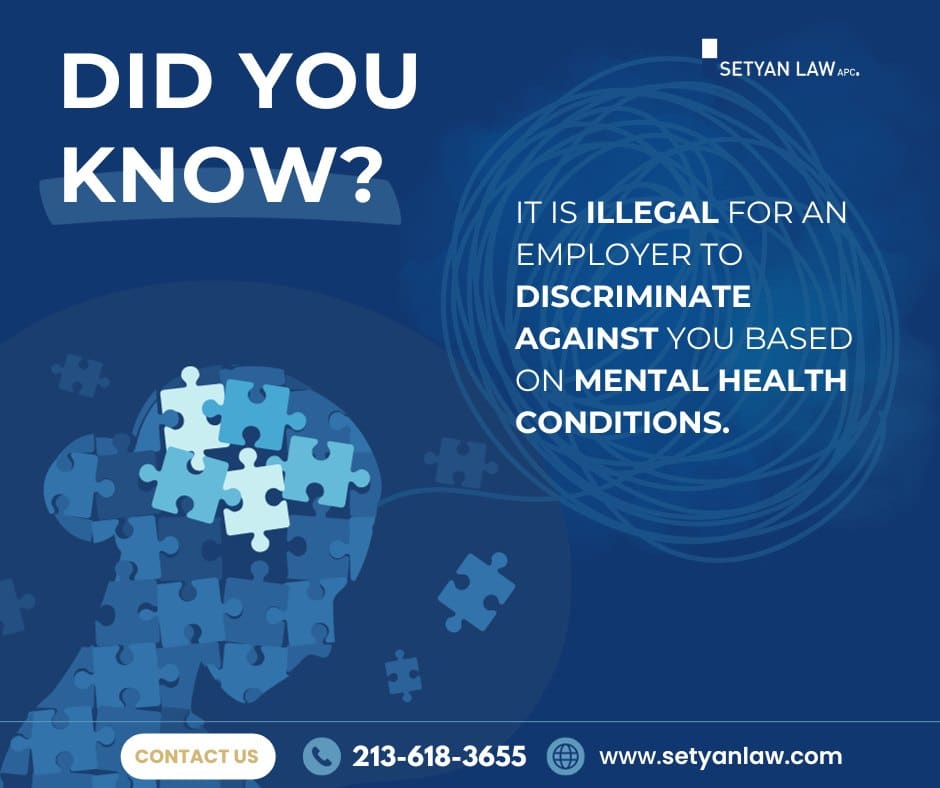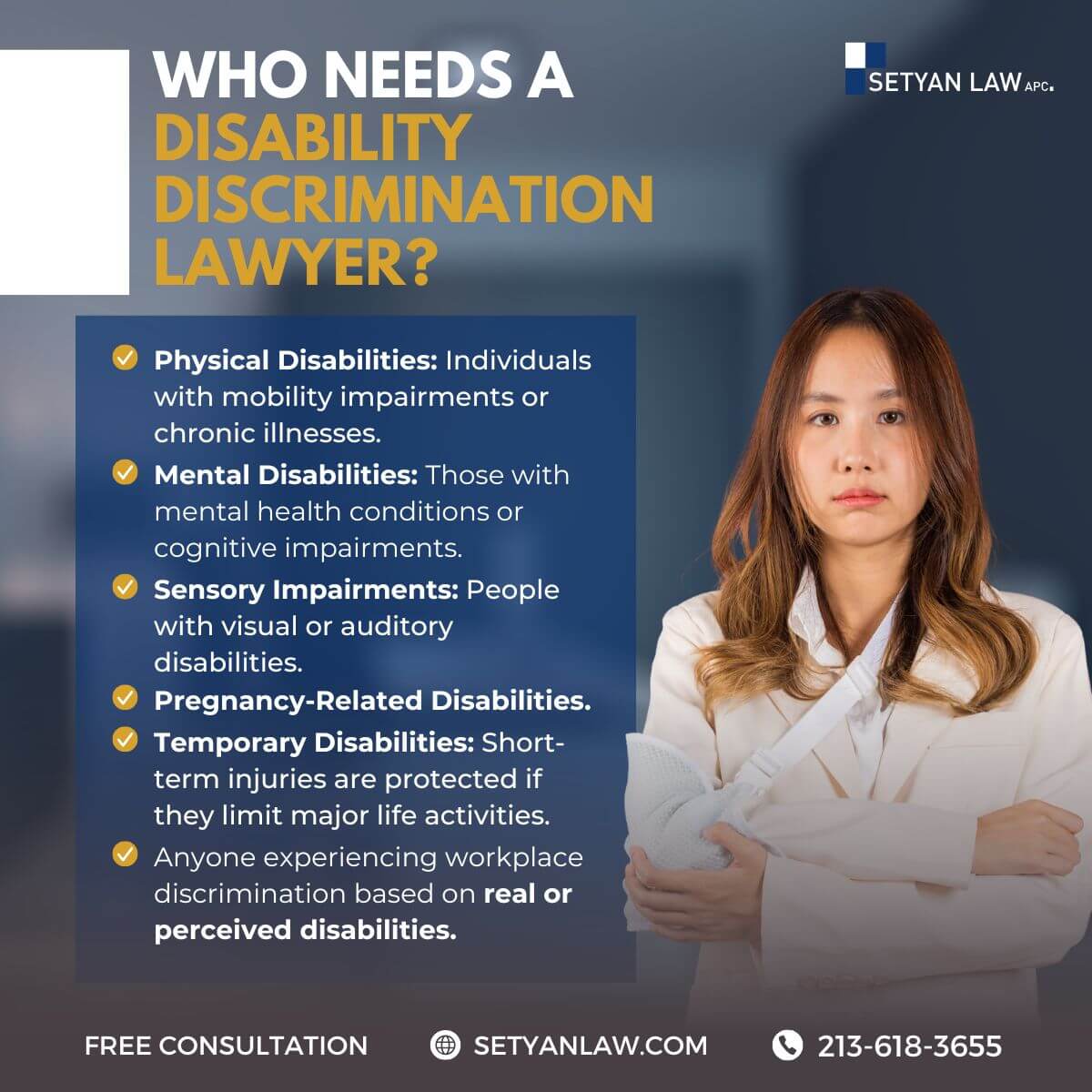Updated November 20, 2025
Forced to Leave Due to Disability? A Worker’s Guide
Is your employer pushing you out due to your disability? Disability discrimination is a legitimate and good reason for leaving a job – but you shouldn’t have to leave without protecting your rights.
Unfortunately, many workers with disabilities find themselves subtly (or not so subtly) pressured to resign when employers are unwilling to provide proper accommodations. Despite legal protections, disability discrimination remains pervasive in workplaces across America.
When facing this situation, understanding your rights under the Americans with Disabilities Act (ADA) becomes your strongest defense. This landmark legislation protects qualified individuals from discrimination and entitles them to reasonable accommodations that allow them to perform their job duties.
This guide will walk you through the essential steps to protect yourself if you’re being forced out due to disability. From requesting accommodations properly to documenting discrimination, understanding the interactive process, and knowing when to pursue legal action – we’ll cover everything you need to know to stand up for your rights.
Remember, being pushed out because of your disability isn’t just unfair – it’s illegal. Knowledge is your most powerful tool in fighting back.
Know Your Rights Under the ADA
The Americans with Disabilities Act serves as your shield against workplace discrimination. Understanding these protections thoroughly helps establish disability discrimination as a good reason for leaving a job—one that may entitle you to legal remedies.
What qualifies as a disability
Under the ADA, a disability is defined as a physical or mental impairment that substantially limits one or more major life activities. This definition extends to individuals who have a record of such impairment or are regarded by others as having an impairment, even if they don’t actually have one.
The term “substantially limits” is interpreted broadly and isn’t meant to be a demanding standard. Furthermore, the assessment should compare a person’s abilities to those of most people in a straightforward, common-sense manner.
Major life activities include:
Daily actions (eating, sleeping, speaking, breathing)
Movement (walking, standing, lifting, bending)
Cognitive functions (thinking, concentrating, learning)
Sensory functions (seeing, hearing)
Working and communicating
Bodily functions (circulation, reproduction, individual organs)
Physical disabilities may include conditions like diabetes, epilepsy, blindness, HIV/AIDS, or paralysis. Mental disabilities can include depression, bipolar disorder, schizophrenia, anxiety disorders, and post-traumatic stress disorder.
What protections the ADA provides
Title I of the ADA prohibits employers with 15 or more employees from discriminating against qualified individuals with disabilities. This protection covers the entire employment relationship, including:
Recruitment and hiring
Job assignments and promotions
Pay and benefits
Training opportunities
Termination
Social activities and other privileges
Additionally, the ADA restricts what questions employers can ask about your disability before making a job offer. Essentially, the law ensures equal access to employment opportunities and prevents discrimination based solely on disability status.
Another critical protection is the right to reasonable accommodation—modifications that allow you to perform your job effectively despite your disability. These accommodations shouldn’t be viewed as “special treatment” and often benefit all employees as productivity enhancers.
Who is considered a qualified employee
Not everyone with a disability automatically receives ADA protection in the workplace. To be protected, you must be a “qualified individual with a disability.”
This means you must:
Satisfy the requisite skill, experience, education, and other job-related requirements of the position
Be able to perform the “essential functions” of the job with or without reasonable accommodation
Essential functions are fundamental job duties that you must be able to perform, as opposed to marginal or incidental tasks. Notably, an employer cannot refuse to hire you simply because your disability prevents you from performing duties that aren’t essential to the job.
If h2,h3,h4{text-transform:capitalize}you meet these qualifications, your employer must engage in an interactive process to identify appropriate accommodations. They can only terminate your employment if:
The termination is unrelated to your disability
You don’t meet legitimate job requirements even with accommodation
You pose a direct threat to health or safety in the workplace
Consequently, being pushed out simply because accommodating your disability seems inconvenient represents a violation of your federally protected rights.
Requesting Reasonable Accommodations
Requesting accommodations remains a critical step in maintaining your employment while managing a disability. Properly navigating this process can make the difference between keeping your position and finding yourself with a legitimate—albeit unwanted—reason for leaving a job.
How to make a formal request
Initiating an accommodation request starts the “interactive process”—a collaborative dialog between you and your employer to identify appropriate workplace modifications. Although the ADA doesn’t require special language or written requests, following these steps increases your chances of success:
First, decide on appropriate timing. You can request accommodations during the application process, at the beginning of employment, or whenever your disability affects your work performance.
Initially, consider putting your request in writing, although verbal requests are legally valid. Written documentation creates a record and eliminates potential confusion later. Your request should clearly explain that you need a change due to your disability.
Remember that a family member, healthcare professional, or other representative can make the request on your behalf. Generally, you need only inform your employer that you need a workplace change because of a medical condition.
Following your request, your employer may ask for documentation about your disability if your limitations aren’t obvious. They can request sufficient information to establish your disability and need for accommodation, although this should be limited to what’s necessary.
Examples of reasonable accommodations
Reasonable accommodations vary widely depending on your specific disability and job functions. According to the EEOC, these may include:
Physical modifications: Installing ramps, modifying restrooms, or changing workspace layout
Schedule adjustments: Part-time or modified work schedules, flexible leave policies, or altered break times
Equipment changes: Acquiring or modifying equipment, providing screen reader software, or ergonomic workstations
Job restructuring: Redistributing marginal (non-essential) job duties or providing checklists
Policy modifications: Allowing service animals, adjusting dress codes, or creating reserved parking
Communication support: Providing sign language interpreters, readers, or written rather than verbal feedback
The most appropriate accommodation often becomes apparent through the interactive process. Your suggestions based on personal experience are valuable, although the final decision ultimately belongs to the employer.
What to do if your request is denied
Although employers must provide reasonable accommodations, they can legally deny requests that would cause “undue hardship”—meaning significant difficulty or expense. Moreover, they can propose alternative accommodations they consider more suitable.
If your accommodation request is denied, take these steps:
Ask specifically why the request was denied. Understanding the rationale helps determine your next course of action.
Explore alternative accommodations. If the original request poses hardship, continue the interactive process to find workable solutions.
File an internal complaint or appeal. Check your employee handbook for formal appeal processes or consider going up the management chain.
Document everything. Keep copies of all correspondence and notes from conversations about your accommodation requests.
Consider filing with the Equal Employment Opportunity Commission (EEOC) if internal options fail. This preserves your legal rights while initiating an official investigation.
Seek legal assistance through state protection and advocacy agencies or disability rights organizations if needed.
Primarily, remember that being denied reasonable accommodation without proper justification constitutes a good reason for leaving a job—one that may qualify as constructive discharge if it creates intolerable working conditions.
It’s always best to consult a qualified Medical Condition Discrimination Attorney regarding your case before you file. Employment law has many pitfalls and an attorney can help you navigate past them safely. Sam Setyan will review your grievance, tell you your options, and guide you to the most favorable outcome possible. It’s your call.
Call 213-618-3655 for a free consultation.
When the Employer Fails to Accommodate
Sometimes employers fall short in their duty to accommodate workers with disabilities, creating a good reason for leaving a job under legal protections. Recognizing these situations early helps you protect your rights and take appropriate action.
Understanding the interactive process
The interactive process forms the legal backbone of disability accommodation. This required dialog between you and your employer aims to identify effective workplace modifications that allow you to perform essential job functions. The process should be a good faith interaction—a collaborative exchange addressing your limitations, the employer’s constraints, and possible solutions.
When accommodation isn’t obvious, employers must follow this framework:
Analyze the job to determine its essential functions
Consult with you to understand your specific limitations
Identify and evaluate potential accommodations
Implement the most appropriate solution promptly
Monitor the accommodation’s effectiveness over time
Importantly, medical documentation should support this process, not replace it. The interactive process continues even after implementation to ensure accommodations remain effective as your needs or job duties change.
Signs your employer is not cooperating
Several red flags indicate your employer isn’t fulfilling their legal obligations:
Automatic denial without assessment: Rejecting accommodation requests without exploring modifications, especially after you’ve provided proper medical documentation
Delays or ignoring requests: Failing to respond or deliberately stalling the process
Lack of genuine engagement: Going through motions without real intent to find solutions
Sudden performance criticism: Receiving negative evaluations shortly after disclosing your disability
Targeted documentation: Creating a paper trail of supposed performance issues after learning of your condition
Vague justifications: Citing general “business needs” without specific hardship evidence
These behaviors may signal discriminatory intent, particularly if your employer’s attitude changed noticeably after learning about your disability.
What to do if you’re being pushed out
If you suspect you’re being pushed out because of your disability, take these immediate steps:
First, document everything. Keep copies of all accommodation requests, employer responses, and emails discussing your disability. Save performance reviews showing satisfactory work before discrimination began. Record dates, times, and individuals involved in relevant conversations.
Second, maintain written records of how job requirements changed after disclosing your disability. Request your personnel file to identify any sudden negative changes in documentation.
Third, continue performing your job to the best of your ability while following the proper channels for addressing discrimination. File an internal complaint following your company’s grievance procedures.
Henceforth, if internal resolution fails, consider filing a complaint with the Equal Employment Opportunity Commission (EEOC). Typically, charges must be filed within 180 days of the discrimination, though this may extend to 300 days in states with additional protections.
Lastly, consult an employment attorney experienced in disability discrimination cases, especially if your employer retaliates after you request accommodations or terminates you shortly after disclosing your disability.
Documenting Discrimination and Resignation
Strong documentation serves as your most powerful evidence if you’re being pushed out of your job due to disability. Proper records transform your experience from mere claims into compelling evidence that can establish disability discrimination as a good reason for leaving a job under legal protection.
Keeping written records of conversations
First and foremost, create a systematic documentation system. Use a personal notebook kept at home or a password-protected digital document on your personal device—never use employer-owned equipment or systems [1]. Each entry should include:
Date, time, and location of incidents
Names and positions of everyone present
Verbatim accounts of what happened or was said
Your reaction and any follow-up actions
Witness names and their immediate responses
Document everything immediately after incidents occur to preserve critical details [1]. Even seemingly minor events should be recorded as they may reveal patterns of discrimination over time. Store your records securely with regular backups to encrypted cloud storage or USB drives [2].
How to write a resignation letter under pressure
If you’re being pressured to resign, remember that resignation is permanent and can potentially affect benefit eligibility [3]. Naturally, how you word your resignation letter becomes crucial to preserving your rights.
When forced to draft a resignation letter:
Never sign pre-prepared forms from HR without review [3]
Take documents home to review or have an attorney examine them
Explicitly state that your resignation is due to your disability
Include your doctor’s name and reference medical restrictions
Mention your intent to apply for any benefits you’re entitled to [3]
A properly worded letter might state: “I cannot continue to perform my duties because I am currently disabled. My doctor has placed me on medical restrictions that prevent me from returning to work indefinitely” [3].
Reviewing your personnel file for evidence
Many states grant employees the right to review their personnel files, typically once per year [4]. Request your file to identify any suspicious changes in documentation after disclosing your disability.
Look specifically for:
Performance reviews showing changes in tone or ratings after your disability disclosure [1]
Documentation of accommodation requests and employer responses
Medical records that should be maintained separately in a confidential file [5]
Evidence of disparate treatment compared to non-disabled colleagues [6]
Significantly, employers must preserve all personnel records related to discrimination charges until final resolution [7]. This includes applications, promotion records, termination documentation, and accommodation requests.
Throughout this process, maintain parallel records of all communications about your employment situation—emails forwarded to personal accounts, texts, written complaints—as they form the foundation for any potential legal action [8].
Filing a Legal Complaint or Claim
When internal remedies fail to address disability discrimination, pursuing legal action becomes a necessary good reason for leaving a job. Understanding the proper procedures ensures you protect your rights effectively.
How to file with the EEOC
The Equal Employment Opportunity Commission (EEOC) enforces federal laws prohibiting workplace discrimination. To initiate a claim:
First, remember strict deadlines apply—you must file within 180 calendar days of the discriminatory act, though this extends to 300 days in states with additional protections [9].
Prior to filing a lawsuit, you must submit a “Charge of Discrimination”—a signed statement asserting your employer engaged in discrimination [9]. Prepare essential information including:
Your contact information
Your employer’s details
Description of discriminatory events with dates
Basis for discrimination (disability)
Upon receiving your charge, the EEOC notifies your employer and may investigate, request additional information, or offer mediation [10].
When to consider a constructive discharge claim
Constructive discharge occurs when an employer deliberately creates working conditions so intolerable that a reasonable person would feel compelled to resign [2]. Courts treat this as involuntary termination, preserving your right to pursue wrongful termination claims.
To establish constructive discharge, you must demonstrate:
Working conditions became objectively unreasonable
Your employer intended for you to quit or reasonably foresaw you would [11]
The intolerable conditions connect directly to your disability
Notably, failure to accommodate a disability can constitute grounds for constructive discharge [12].
Getting legal help and support
Undoubtedly, navigating disability discrimination claims requires specialized knowledge. Consider these resources:
Consult an employment attorney experienced in disability discrimination cases
Contact state protection and advocacy agencies
Reach out to disability rights organizations for guidance
Remember that even if the EEOC doesn’t resolve your claim, they may issue a “Right to Sue” letter, giving you 90 days to file a lawsuit [13].
Call Setyan Law at (213)-618-3655 to schedule a free consultation.
Conclusion
Facing disability discrimination at work creates an emotionally and financially challenging situation. Your knowledge of ADA protections stands as your strongest defense against unfair treatment. Throughout this difficult process, remember that disability discrimination constitutes a legally protected reason for leaving your job.
Documentation proves absolutely essential when building your case. Each conversation, email, and denied accommodation request forms part of the evidence that could support future legal action. Additionally, the interactive process remains your right—not a privilege that employers can ignore or dismiss.
Reasonable accommodations allow qualified employees with disabilities to perform their essential job functions effectively. Therefore, when employers refuse to engage meaningfully in this process, they violate federal law. The steps outlined in this guide help ensure you protect your interests while navigating these challenging circumstances.
Many workers unfortunately face subtle pressure to resign rather than receive proper accommodations. Nonetheless, understanding constructive discharge claims offers another avenue for protection when working conditions become intolerable. Legal resources exist specifically to support individuals in your situation—from disability rights organizations to employment attorneys specializing in discrimination cases.
Above all, remember that your disability does not diminish your value as an employee. The law recognizes your right to equal opportunity and fair treatment. Armed with proper documentation, knowledge of your rights, and appropriate legal support, you can effectively address disability discrimination and make informed decisions about your professional future.
References
[1] – https://www.arcelawgroup.com/blog/2025/october/documenting-disability-discrimination-at-work/
[2] – https://www.nisarlaw.com/blog/2025/july/constructive-discharge/
[3] – https://www.nickortizlaw.com/resigning-due-to-a-disability/
[4] – https://www.fwlaw.com/insights/does-an-employer-have-to-allow-employees-to-review-their-personnel-files
[5] – https://adata.org/faq/what-are-employers-recordkeeping-requirements-under-employment-provisions-ada
[6] – https://www.littler.com/press/external-publication/discovery-personnel-records-employment-discrimination-cases
[7] – https://www.eeoc.gov/employers/summary-selected-recordkeeping-obligations-29-cfr-part-1602
[8] – https://fraigunlaw.com/resign-under-duress-in-california/
[9] – https://www.eeoc.gov/filing-charge-discrimination
[10] – https://www.americandisabilityactiongroup.com/filing-an-eeoc-complaint-for-disability-discrimination-step-by-step-guide/
[11] – https://www.adagreatlakes.org/Publications/Legal_Briefs/BriefNo19_Update_on_Emerging_ADA_Issues_Disability_Harassment,_Retaliation_and_Constructive_Discharge.pdf
[12] – https://www.stoelrivesworldofemployment.com/2008/09/articles/cases/failure-to-accommodate-disabled-employee-may-result-in-constructive-discharge/
[13] – https://www.watsonnorris.com/claiming-your-power-a-step-by-step-guide-to-disability-discrimination-claims
Call Setyan Law at (213)-618-3655 to schedule a free consultation.








